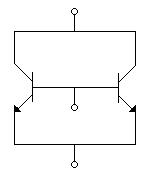ECE :: Electronic Devices and Circuits
-
A varactor diode is used for
-
Assertion (A): When VDS is more than rated value the drain current in a JFET is very high.
Reason (R): When VDS is more than rated value, avalanche breakdown occurs.
-
If ib is plate current, eb is plate voltage and ec is grid voltage the v-i curve of a vacuum triode is
ib = 0.003 (eb + kec)n. Typical values of k and n are -
In which material do conduction and valence bands overlap
-
For a photoconductor with equal electron and hole mobilities and perfect ohmic contacts at the ends, an increase in illumination results in
-
Discrete transistors T1 and T2 having maximum collector current rating of 0.75 amp are connected in parallel as shown in the figure, this combination is treated as a single transistor to carry a total current of 1 ampere, when biased with self bias circuit. When the circuit is switched on, T1 draws 0.55 amps and T2 draws 0.45 amps. If the supply is kept on continuously, ultimately it is very likely that

-
Assertion (A): A high junction temperature may destroy a diode.
Reason (R): As temperature increases the reverse saturation current increases.
-
The SCR would be turned OFF by voltage reversal of applied anode-cathode ac supply of frequency of


 Whatsapp
Whatsapp
 Facebook
Facebook


 = 200 μsec.
= 200 μsec.